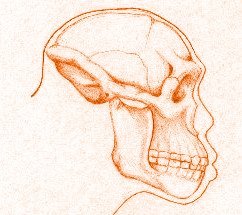| Seafood = Brain Food!! |
| We have big brains relative to our body size. This is another commonality we share with the other aquatic and semi-aquatic mammals. The dolphin is the only other mammal that comes close! This larger brain size was established by 1.8 Ma, which means that the move toward a larger brain must have began earlier, somewhere between 2-3 Ma. This driving force must also have been very strong in order to result in such a drastic increase in comparison to all other primates. Considering that stone tools are found in the 2 Ma time frame, this may indicate an increased ingenuity. The earliest tools are often chipped stones. Very useful for scaling fish, and breaking open mollusks! This mode of attaining essential proteins and fatty acids, required for brain development and growth, is much easier than hunting a fast, well adapted savanna dweller. We must keep environmental factors and diet in mind when considering brain size and development, for after all, we are what we eat! | |

Illustration courtesy Dr. Patterson Marine and lacustrine food sources have been essential in human populations for tens of thousands of years. Why then, has this not been considered as part of our evolutionary diet for millions of years back? |
There is a possible link between marine-based diets and brain size and developement. Recent research has shown that the overall trend in brain size has decreased in mammals and primates evolving in the African savanna ecosystems (S.C. Cunnane et al., 1999). This decrease has been linked to a deficiency in the savanna food chain of "Docosahexanoic acid", DHA. This molecule is required for brain growth and development and is not found in much abundance in dry inland regions. It is found in great amounts in the marine and lacustrine (lake) food chains (S.C. Cunnane et al. 1999). It has been further suggested, and supported by contemporary data, that the expansion of the human brain began at the water/land interface brought about by a diet laden with marine and lacustrine food sources (Ellis 1993). Brain development in newborn humans is unparalleled in the primate family. It has been suggested (Cunnane et al. 1999), that the large fat reserves in human infants allows them to fulfill the requirements of a growing brain. The best source of all the nutrients demanded by the developing brain is the marine/lacustrine habitat. Iodine, zinc, and long-chained polyunsaturated fatty acids are found in highest abundance in this environment. Without these nutrients early in life, impaired brain function can result (S.C. Cunnane et al., 1999). |
| There is evidence for marine diets in early hominids, provided in dental enamel micro-wear studies of fossil teeth. Studies of Australopithicus afarensis , show close resemblence to patterns found on living capybaras (a semi-aquatic rodent), and mountain beavers (Peuch et al;1986). Further, it has been reported that if compared to any other mammal, the teeth of early hominids, the Australopithecines, resemble most closely those of the sea otter, with thick enamel and large flat molars with small front teeth (Walker 1981). A diet of marine invertebrates (mussels, shellfish etc.) would also encourage suction feeding and greater lip control (Morgan 1997), which may help to explain our very different and sensitive lips. |
 Australopithecus afarnesis "Lucy" |
| Without the development of large organized brains, all the other pre-adaptations would have never been utilized to their fullest. Advanced tool use and speech would never have happened, complex and symbolic thought processes would not have arisen. Art, language, society and culture would never have been possible, the world would be a very different place. We would have been the same as any other of the great apes in these regards. Again, we are left explaining how did our brain get so large when all other terrestrial African savanna dwellers went the opposite route, i.e. their brains decreased in size!! If our forebearers weren't avid waders, swimmers and divers, exploiting the aquatic environemts, as well as the terrestrial, then how would they have acquired the necessary nutrients for increased brain development? |
Back to Contents
Back